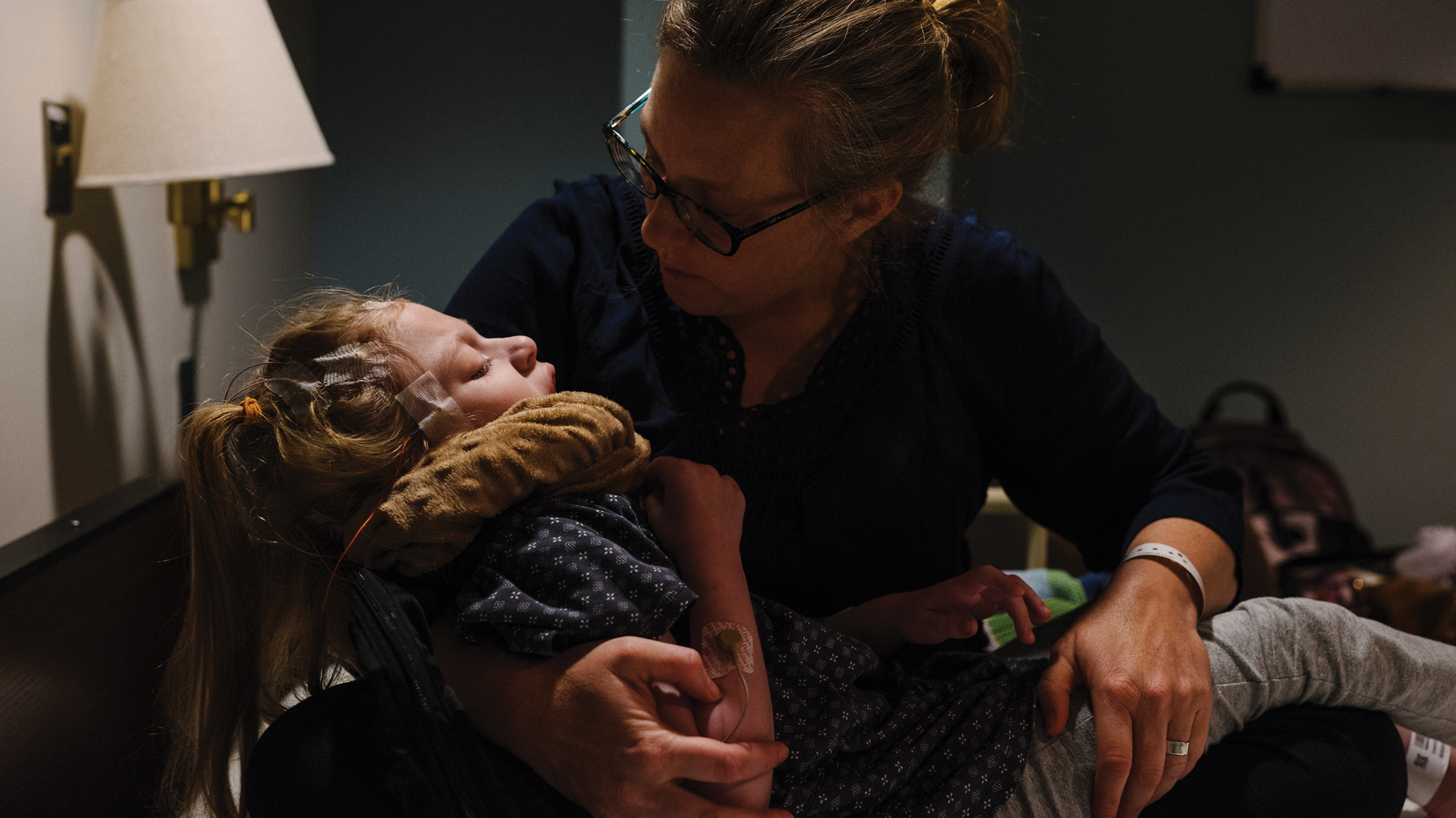A monster snowstorm had just walloped North Carolina, and the city of Greensboro careened to a halt. Families were home building fires, sticking carrot noses in snowmen, sipping mugs of hot cocoa. Dan Smith, though, was worried. When he awoke that morning in January 2018 and saw his street hidden under a thick white blanket, he pondered how hard it would be to get to a hospital.
Two of his kids—Asher, eight, and Reese, four—ran in and out of the house in winter coats, cheeks pink, begging to go sledding. They weren’t the ones he was concerned about. Smith worried about his daughter Moira.
In some ways, Moira is like a lot of six-year-olds: She loves bubble baths, giggling with friends, and vanilla frosting. She has tremendous blue eyes, a toothy smile, and cascading blond hair. But in other ways—ones you notice as soon as you meet her—Moira is different. She can’t sit up and has only ever said a few words. When Dan’s wife, Dania Ermentrout, gave birth to her in 2012, Moira seemed healthy, but she struggled to nurse and soon began to twist and writhe. After many tests, Moira was diagnosed with pontocerebellar hypoplasia Type 2A, a rare disease caused by an inherited mutation that interferes with the growth of the cerebellum, the brain hub that coordinates muscle movements, and the pons, part of the brain stem. She has frequent seizures and poor muscle control and can’t swallow. For the rest of her life, Moira will need regular care at home and occasional emergency hospital care.
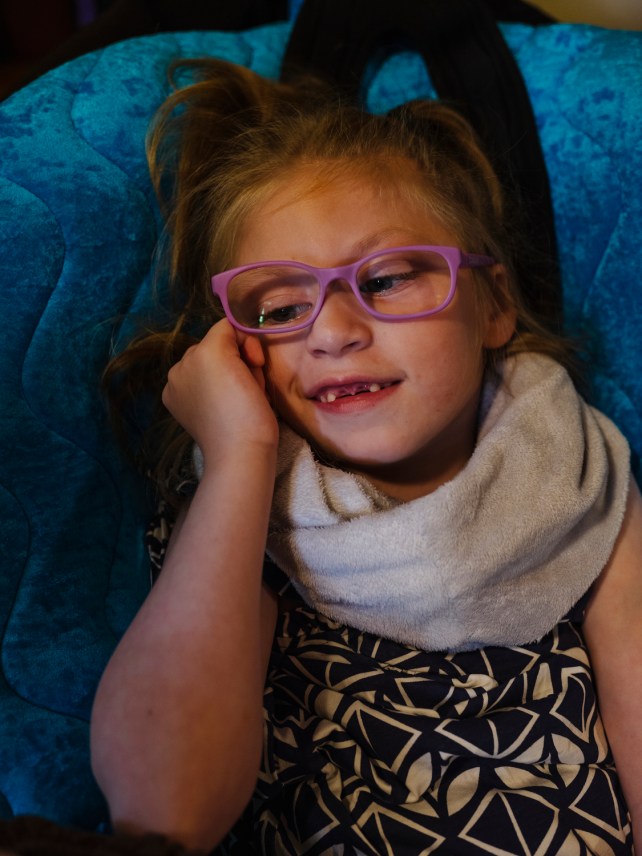
The very fact that Moira is alive is a miracle of modern medicine: Had she been born a century ago, she likely would have starved to death as an infant or succumbed to a deadly seizure. Instead, Moira eats via tubes that connect liquid food directly to her stomach and intestines, and a careful concoction of medicines keeps her nervous system quelled.
Moira is one of about 400,000 “medically complex” American children—kids who have serious health issues but who, thanks to modern technology, can survive past infancy and even lead long, fulfilling lives. Yet the US health care system is increasingly failing children like her. Even the best private health insurance doesn’t begin to cover all their care, which can cost an estimated $140,000 per child per year. A 1982 Medicaid fix was supposed to ensure that medically complex children could get essential help at home, but states have quietly eroded those provisions. Kids who used to be eligible for home services are now denied, put on yearslong waiting lists, or forced into plans that do not meet their many needs.
Because Dan and Dania couldn’t get the nursing help they needed, Dania—whom I’ve known since kindergarten—had to quit her job as a researcher at the University of North Carolina-Chapel Hill. They spent so much money on medical equipment and other essential gear that, although Dan is a successful lawyer, they went deep into debt. Talking about these sacrifices still brings Dania to tears.
Yet Moira’s family is lucky. Nearly 200 medically complex kids in Florida were denied home health care in 2012, according to the Justice Department. It’s unclear how many of them are still in institutions—and how many children in other states have been taken away from their families because they couldn’t get the home care they needed. “It is very easy to marginalize an invisible population,” says Hannah Mehta, a co-founder of Protect TX Fragile Kids, a Texas-based advocacy organization, and mom to Aiden, 11, who was born with serious respiratory and digestive problems. “And that’s precisely what our kids are.”
Listen to Dania Ermentrout share the extraordinary challenges of raising and caring for her daughter, Moira, alongside journalist Melinda Wenner Moyer, on this episode of the Mother Jones Podcast:
The catch-22 of caring for medically complex children is that it can cost about $49,000 per month to hospitalize a child, compared with roughly $10,000 to care for one at home. Yet many shortsighted politicians don’t realize this, and families don’t always have the time or political will to fight back. In July 1978, Katie Beckett, a four-month-old with dark hair and wide-set brown eyes, developed acute brain inflammation following a viral infection. Katie was admitted to the hospital in her hometown of Cedar Rapids, Iowa. She suffered seizures and nerve damage and went into a coma. She eventually woke up, but her diaphragm was partially paralyzed so she had to breathe with a ventilator.
Katie’s hospital costs soon exceeded the lifetime maximum on her parents’ private health insurance. Medicaid then kicked in to foot her bills—so long as she stayed in a hospital. Her parents calculated, though, that if they could bring her home with that ventilator, her daily medical costs would be one-sixth what they were at the hospital. Yet they couldn’t, because then she would no longer qualify for Medicaid, and they couldn’t afford the ventilator without it. Katie’s mother began contacting local representatives, and the story of their family’s predicament made its way to President Ronald Reagan. In November 1981, his administration waived existing Medicaid rules and let Katie go home. The next year, he signed the Katie Beckett waiver into law—it allows children with complex health needs to qualify for Medicaid regardless of their parents’ income so that they can live at home. Katie eventually went to college and became an advocate for children with special health needs. In 2012, she died at age 34 in that same Cedar Rapids hospital.
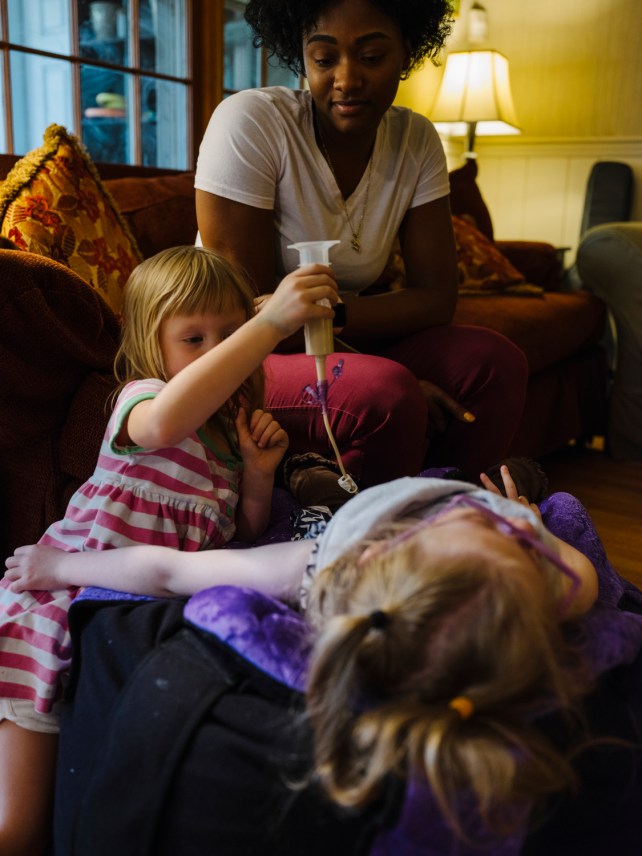
Matt Eich
Every US state soon adopted some kind of Medicaid waiver or special program. But while many aspects of Medicaid are federally mandated, these programs are entirely optional, and states can set their own rules. For one, they can limit how many children they will serve. More than 16,000 medically complex kids in Texas are wait-listed for a waiver.
States have been tinkering with eligibility criteria, too. After a 2014 standards revision, Illinois denied nursing care to 66 percent of the first 178 kids it reevaluated, all of whom had received nursing care under the previous standards. Another 32 percent had their nursing hours cut, leaving just 2 percent with the same level of care as before. In 2015, Florida shifted 13,000 disabled children to other Medicaid plans that did not provide the same level of services. Moira, too, was deemed ineligible for North Carolina’s Medicaid waiver at first—the rejection letter explained that she “does not appear to meet the criteria” because her “care needs are not continuous and complex.” Yet Moira can’t walk or use a bathroom, and she has epilepsy, takes at least 10 medicines each day, and eats through two feeding tubes. Just one of her medications costs $2,500 a bottle, and she needs a refill every three weeks.
When children who require home care can’t get it, parents face a difficult choice: They can either put their kids in an institution or find some way to care for them at home—even though many need constant care. “If a child is on a ventilator and requires feeds or suctioning every two to three hours, that’s extremely burdensome and not even safe for a parent to do around the clock,” says Tamara Simon, a pediatrician at Seattle Children’s Hospital.
Some parents eventually become too exhausted to provide their children with what they need. Single mother Tennille Bozeman recalls feeling so overwhelmed after multiple nights up with her medically fragile son, Jett, who had not qualified for Utah’s Medicaid waiver, that she brought him to the hospital and had him admitted. “I was beyond tired, and I was at my wit’s end, and there was nothing I could do to help him,” she recalls. He died there in March 2017.
The morning after the snowstorm, Dania walked into the kitchen, cradling Moira like a baby, looking exhausted. She had been up much of the night because Moira was agitated. Moira can’t sleep in a regular bed by herself—she can roll over but can’t roll back, so she might suffocate. “I don’t know what is going on with her,” Dania said in a low, somber monotone.
Asher, their eight-year-old, pointed out that Moira’s hair was damp. They took her temperature and it was 101 degrees. “I’m a little bit worried that she’s having seizures,” Dania said. Moira had suffered a grand mal seizure at night a few years ago and didn’t smile afterward for an entire week. Recalling the episode, Dania’s voice shook. “We have so few things,” she said. “I was bereft to think that we might have lost her smile.”
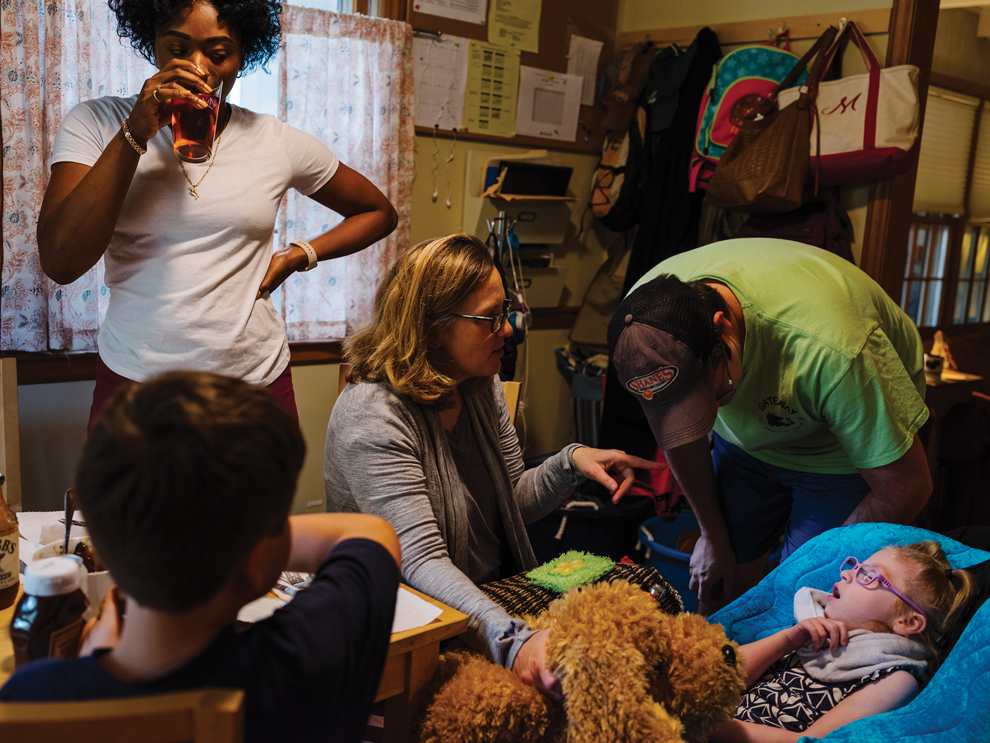
Matt Eich
Dan and Dania, who finally got approved for their state Medicaid waiver in 2015, could benefit from a night nurse, but even if they tried, they might never get one. “I’d have to find someone who’d be willing to do that shift,” Dania says, which can be next to impossible, and not just in North Carolina. Recent statistics document that in Vermont, families on average only receive 50 percent of the nursing hours they are allotted; in California, it’s 71 percent.
The crux of the problem is this: There’s a national shortage of nurses, and Medicaid reimburses home health nurses so poorly that not many want the work. “If you are a registered nurse or licensed practical nurse, then you can get a job in a hospital for twice the amount of what you would be paid as a home nurse,” explains Elena Hung, co-founder of Little Lobbyists, a DC-based organization that advocates for medically fragile children. Moira’s nurse aide is paid $16.25 an hour—some teenage babysitters earn more.
Low reimbursement rates have dangerous implications for care quality. Some nurses only take domestic jobs because they can’t get hospital positions, perhaps because of skill deficits. Hung, for one, hired and fired 36 nurses over 15 months because she couldn’t find anyone qualified to care for her daughter, Xiomara, who has a rare condition in which her trachea collapses when she breathes. Michelle Morrison, whose wait-listed son was able to get some nursing hours through private insurance in Maryland, had a similar experience. One day she stumbled upon a nurse putting medicine into the wrong part of his feeding tube. “We came in another morning and his feeding tube was out and the pump was just pumping into the bed,” she recalls.
Certain types of nurses aren’t even allowed to give kids medications in some states. “Lydia gets over 10 medicines a day, and who does that? Me,” says Elaine Nell, co-founder of the nonprofit organization Advocates for Medically Fragile Kids NC. Lydia is missing a large portion of her intestines, and she can’t survive without her drugs, so Elaine has to stay home all day, even with a nurse there to help.
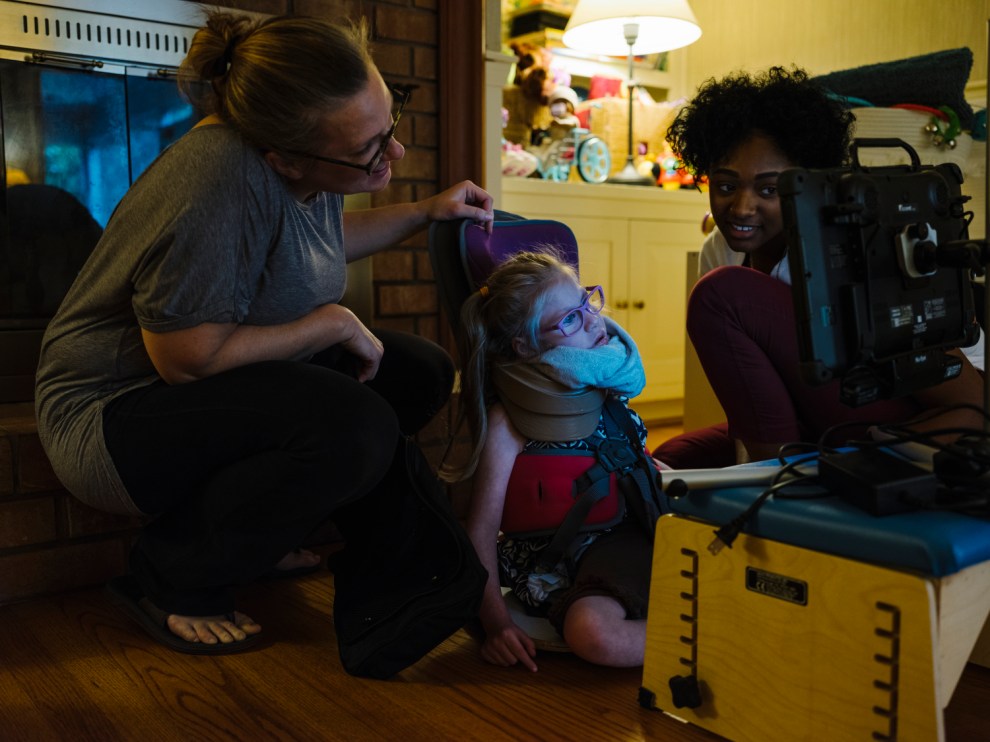
Matt Eich
And what Medicaid offers tends to favor wealthier families. It can pay for home modifications to accommodate shower chairs, for example, but few renters can take advantage of these benefits. Dania also knows families who are homebound because their children’s wheelchairs don’t fit in their cars. “There’s no recourse,” Dania says, “because nobody’s going to buy you a car.”
It’s easy to guess why states deny care to children like Moira: They don’t want to pay for it. While these kids make up about half of 1 percent of all US children, they account for one-third of children’s health care spending—about $100 billion a year. And Medicaid funding in many states is under threat. Since Medicaid is a federal-state partnership, the total amount a state spends in a given year on it depends in part on federal funding. The Trump administration said it plans to switch to block grants, an approach in which the government gives each state a yearly fixed amount. This system often leads to cuts in services to vulnerable populations; since waivers are optional, they may be among the first targets. The recent Medicaid expansions in Virginia and other states also do not improve waiver access.
Yet Medicaid waivers actually reduce health care spending in the aggregate. Katie Beckett cost Medicaid six times as much in a hospital as she did at home. Kids with adequate home care are also less likely to be taken to the emergency room.
Even waivers that provide nonessential health care save money. In 2006, California approved a pediatric palliative care waiver that allows children with life-limiting or life-threatening conditions to access palliative care—pain and symptom management and counseling that often lie outside the realm of what many would consider medically necessary. Yet when UCLA researchers analyzed the program, they determined that the waiver saved the state more than $2,000 a month per medically fragile child—a grand total of $7 million over the three-year pilot period. With palliative care, “there are decreased hospital admissions and shorter lengths of stay,” says Amy Houtrow, chief of the division of pediatric rehabilitation medicine at the UPMC Children’s Hospital of Pittsburgh, and “that leads to an opportunity for less aggressive care.”
So why are states continuing to make cuts? Shortsightedness plays a role: Politicians want to show they spent less this year than last—over the short term, cuts to these programs do save money. And since families of medically fragile kids are busy keeping their children alive, they don’t always have time to find a political voice.
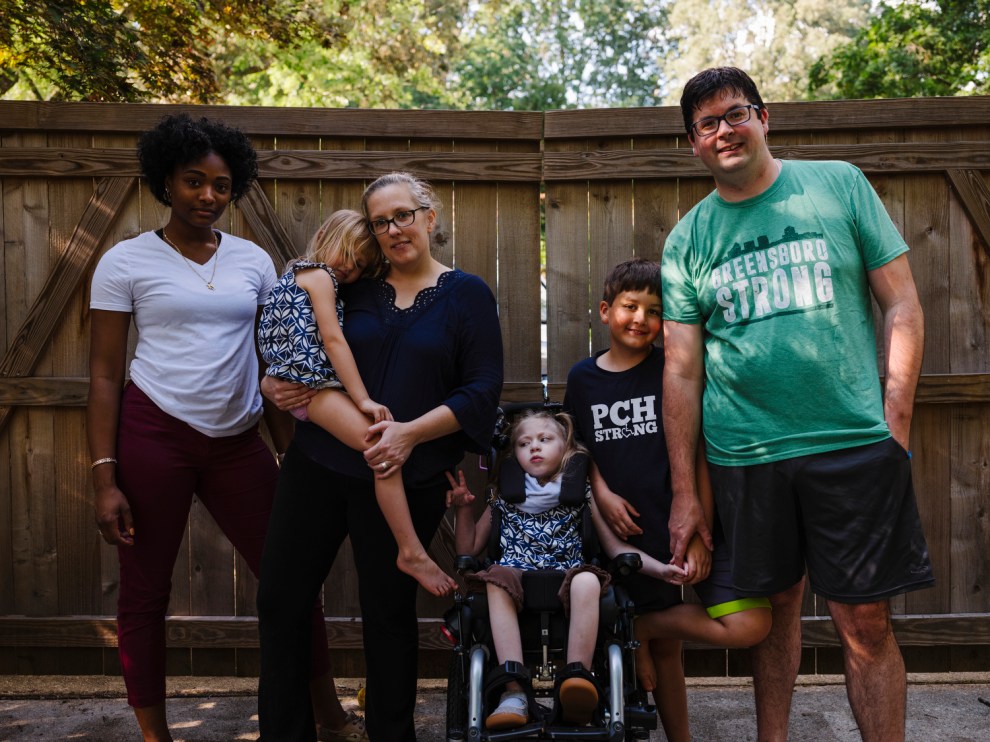
Matt Eich
Dania does, though. After Moira and 22 other North Carolina children were unexpectedly dropped from a program offering hospice and palliative services, Dania helped raise almost $25,000 to ensure they have an alternative route to care. She has also taken a part-time job as a Medicaid waiver case manager, helping families apply for and manage their waivers, which she can do at home with Moira by her side.
As for Moira, she turns seven in February—a bittersweet milestone, because many children with her condition die around this age. She’s still thriving, but she has started to need daily oxygen. It’s a possible sign of central apnea, when the brain stops telling the body to breathe. Yet Dania and Dan embrace the light with the dark. “Her presence allows us to live in the moment and relish our time with family in ways we never expected,” Dania says. “Whatever story she writes, she will be well cared for and deeply loved.”
This story has been updated to reflect the correct spelling of Brayboy’s name and the types of home modifications that Medicaid typically covers.
